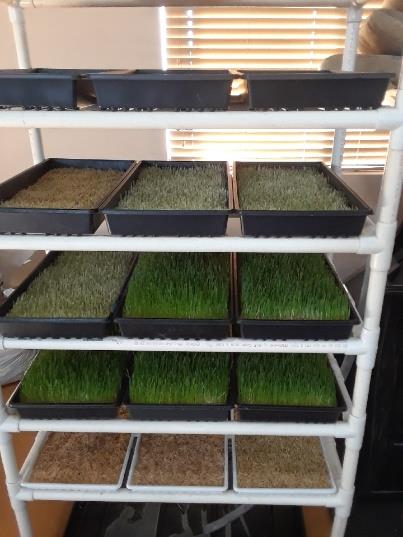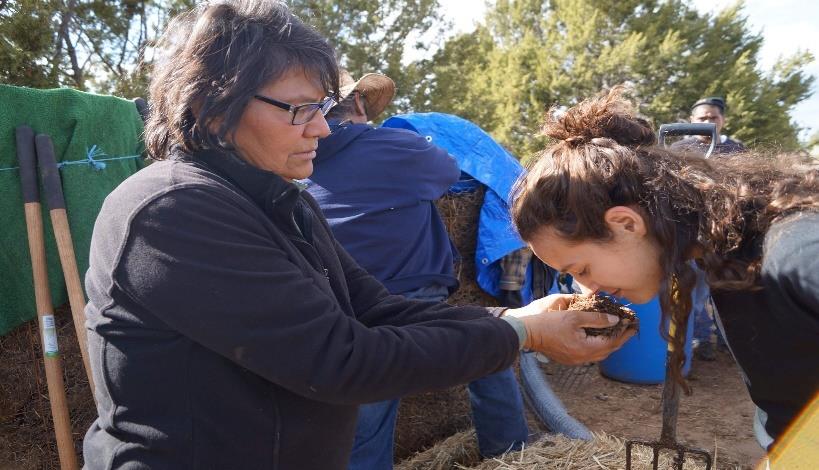Five years ago, we were so excited to start our own flock of sheep. We purchased four, young, pregnant ewes and eagerly awaited the arrival of our first lamb. He was born on a cold, February morning. Watching the mother, we soon realized she did not want anything to do with her new baby. So we became the parents, feeding the little one a home made mixture of cow’s milk and eggs, three times a day.
We named the little lamb Beh Beh, shortened from Abeh, the Navajo word meaning milk. And Beh Beh soon became our farm’s mascot. Beh Beh would follow us everywhere we went, charming each farm visitor. We adored Beh Beh and he trusted us with his life, completely dependent upon us for everything.
After two months, we noticed Beh Beh was growing more slowly than our other lambs. Not thinkin g much about it at the time, we continued to bond with him and enjoyed his company as though he were one of our own children. That is until one day, while checking on the animals after a weekend away, we saw Beh Beh laying in an unusual position. Dead.
Our hearts sank, and we cried and cried at the loss of his companionship. We noticed globs of wool peeling off as we cradled him in our arms. It was in that moment we realized that his nutritional needs had not been met through the cow’s milk and egg recipe we had found on the internet. Yet we didn’t know how or why. It turns out, sheep ’s milk is the most nutrient rich of all milks, and without those vital nutrients, the health of Beh Beh quickly deteriorated. Additionally, the cow’s milk we used was store bought and ultra pasteurized. While our home made mixture was rich in protein, it lacked the vital nutrients for little Beh Beh’s survival. And the pasteurization process further depleted the nutrients and left the remaining nutrients bio unavailable, exacerbating the problem. The same goes for humans. Without nutrient rich foods, our health quickly deteriorates.
Over the past several years, our quest to learn as much as we can about nutrient rich foods has left us startled by that lack of nutrients in our everyday food. Modern produce is grown to look good, to ship without sustaining damage, to be large in size and mass produced. But it is not grown to be healthy, and our health suffers greatly for it.
We recall a visit to an environmental center where the director told us that 60% of the 5th grade students, who participated in a weeklong outdoor education experience, were on medications. That blew our minds. Fifty years ago, that was unheard of. This is a red flag to reevaluate our food and environment. The medicinal properties of food are established by the microbiome of the soil The microbiome of our gut is determined by the foods we eat. The lack of healthy foods is related to the lack of proper gut function and directly correlated to the use of fungicides, pesticides, herbicides and other chemicals used to grow food. We ingest these poisons which create holes in our gut lining, resulting in “leaky gut syndrome.”
Furthermore, the flavor industry has hijacked our taste buds with artificial flavors (preferring to label them as “natural flavors resulting in addictive, eating disorders. We behave much like substance abusers, eating for psychological reasons rather than hunger satiation. Food that used to only need salt and pepper for seasoning has been replaced by artificial flavors. The complex chemical industry controls every layer of food we eat to the point we have dumbed down our most amazing instrument our taste buds. This food, driven by companies like McCormick, has co-opted what the consumer will buy. And the fast food industry continues the assault on our taste buds and our health.
At Spirit Farm, our demonstration and research farm, we are looking for ways to increase the nutrients in the foods we grow in our gardens and in the meats we raise on our pastures, all without expensive inputs. It’s important to demonstrate approaches for increasing nutrients in foods so others can adopt and quickly apply them.
For example, one of the low cost animal feeds available is trash popcorn. While neither popcorn nor native (flint) corn are GMO, most dent/field and sweet corn are. We ferment the popcorn before feeding for two reasons: (1) it increases the bioavailability of the nutrients in the digestive systems of the animals, and (2) it has potential to remove toxic fertilizers.
One time, when trash popcorn was unavailable, we reluctantly purchased the dent/field corn. After several days of feeding the GMO corn to our chickens, we noticed that none of our 25 chickens were laying eggs. Not one egg! Puzzled, we looked at each other, unsure of what was going on. After several more days of no eggs, we connected the lack of eggs to the GMO dent/field corn. Finally, when the trash popcorn became available the chickens resumed laying eggs. Regrettably, this has not been the only occurrence. Every time we fed our chickens the GMO dent/field corn, the chickens stop laying eggs.
At our farm, we are careful about NOT purchasing GMO foods and feed, like corn, potatoes, and soybeans, because they lack the nutrients to keep us and our animals healthy. And seldom do we eat a vegetable from a grocery store that has the flavor of “That is how we described our carrots and broccoli this year. The importance of microbe rich compost became clear these past 2 years.
In July 2019, we embarked on a two year research project, supported by a grant, to compare the number of soil microbes with the nutrient richness of vegetables grown in that soil. This project included five other native growers. In preparation for the planting season, we worked hard to produce compost with lots of microbes. Each spring, summer and fall, we looked at the soil from all of the gardens under a microscope to count the number of microbes. In the fall, we tested the vegetables and leaves of the plants at each of the gardens with a refractometer to determine the brix, or nutrient level, of the plants. The results showed that the more microbes present in the soil, the higher the brix. High brix scores means greater nutrients and sweeter taste. The brix scale goes up to 30. If the brix hit a 9 for the carrots, we were in heaven. Yet, over 50 years ago, most veggies would have tested above 18. Modern farming has changed all that, choosing profitability over taste and nutrient content.
During our brix tests these past two years at three different gardens, we discovered the small, cherry tomatoes had the highest brix scores and the best flavors of all the tomatoes. In each case, we found the more soil microbes, the higher the brix, and the sweeter the tomatoes. Using the refractometer, we also tested foods from other local growers, organic foods in stores, and non organic foods. The cherry tomatoes from local growers with healthy soils still tested the highest. Sometimes store bought, organic che rry tomatoes were high, but not always. And the non organic cherry tomatoes were always low. The brix scores were similar across many food varieties we tested, including a wide array of grocery store vegetables. Eighty percent of the time, organic vegetables had higher brix values than non organic. In general, the smaller sized veggies had the higher brix values.
Another discovery we made during this research project was that native corns had much higher brix values than non native corn. And when grown in microbe rich soils, the brix was even higher. We give much credit to our native ancestors for passing down the sacredness of protecting seed purity, just one aspect of agriculture we refer to as Indigenous Regenerative Intelligence. The purity of the seeds, combined with the healthy microbial soils, is like discovering a gold nugget, a nugget that provides the nutrients so inherently necessary for our well being and the healing of our bodies souls, and spirits.
We pride ourselves in eating from our garden and knowing our vegetables are more nutritious. When we need to purchase foods from a store, we look for organic. Organically grown foods, at least, do not use glyphosate and other inorganic fertilizers that deplete the food nutrients. But organic is not always an option or affordable We are looking forward, with great anticipation, to the time when we will have a better measuring tool for nutrients. That will open the door to do more research comparing the microbes in the soil to the nutrients found in the produce grown in gardens across the Navajo reservation. And it just might happen this growing season.
Recently, we were on a call with scientists trying to find a better way to measure the nutrient density of foods using a spectrometer, as the refractometer has its limits. The challenge is the spectrometer must be programmed for a specific nutrient or compound. Did you know that a banana has potentially over 20,000 healthy compounds? That is mind blowing. In the book, The Dorito Effect, the author tells a story of a time when the vanilla bean was not available. Companies scrambled to create their own imitation vanilla extract. The difference? The imitation extract had only 37 compounds while the real vanilla had many times more.
We are missing out on so many nutrients in our food. The best place to get the nutrients is from healthy soil, full of living microbes, that makes and creates all of those compounds full of medicinal qualities. Our ancient, native ancestors knew this. They also knew that the soil microbes were the foundation for LIFE: healthy people; nutrient rich meats from healthy animals; nutrient rich fruits and vegetables; healthy ecosystems and a healthy environment. Our ancestors adapted to nature, rather than try to control nature for capital gain. We continue to come across non native organizations whose sole intent is economic gain through exploitation. It is time to create an alternative and move toward locally grown, nutrient rich foods.

This spring, as we drove up to take a soil test for the research, Caroline was outside watering her flowers. Her flowers exuded beauty and elegance. She had put a lot of compost and mulch on her garden throughout the winter. And since planting her vegetables, she was watering her 30’ by 30’ garden twice a day. We gathered several soil samples and headed home to look at them under the microscope. Of the six gardens in the rear project, she had the highest number of soil microbes for the first test of the season. However, as the growing season progressed, her soil microbe numbers declined. When asked at the end of the growing season, she told us she had to cut way back on watering due to the high cost. Her water bill had exceeded $200 a month. That tugged at our hearts. Time to find alternative water options for Caroline. Come spring, we at Spirit Farm will begin experimenting with grey water recycling.
Our journey in growing nutrient rich foods continues to be alarming because the more we learn the more we realize how unhealthy our food is and how many nutrients it lacks. And especially in native communities, growing our own vegetables and raising our own meats is really the only viable option we have. The better, nutrient rich food in our markets is priced out of our reach.
For Covenant Pathways and Spirit Farm, it is important, now more than ever, to continue supporting native families in obtaining materials to start and expand their own little, backyard farms. This past year we assisted 28 do it yourself (DIY) growers. We have even more natives interested in starting gardens in 2021.
Our research comparing the soil microbes with the brix is important and we hope to be able to continue. It has allowed us to find answers and to share better methods with the native growers. Understanding is essential to applying methods that increase the soil microbes. It is music to our ears to hear things like “I picked green beans every day for several weeks this year and my veggies tasted sweeter than the ones I buy in the grocery store.” This is how change happens.
At Spirit Farm, the microbial numbers increased exponentially by the end of our growing season. We had the most bountiful harvest ever, and the soil and nutrient tests confirmed the richness and health of the soil and vegetables. We are ready to take the next step to expand our garden area so that we can grow affordable, healthy food for our native community, increasing the outreach capacity locally. The impact of COVID is pushing us in to larger production and we are unable to do so without a well on our property. We currently depend on two sources for water: haul water from Gallup a 20 mile drive one way and collecting rainwater. We need $40,000 for a fully functioning well. Your help would increase our ability to expand our production of healthy food to the community. Donations can be made here Or mailed to: Covenant Pathways, PO Box 455, Vanderwagen, NM 87326
Just like Beh Beh if we as people do not begin getting the nutrients in our bodies through healthy soils we will continue to spiral with rising health challenges related to nutrition. A
number of scientists have found that the lack of nutrients in our food is already increasing sterility. We can make pivotal changes and regenerative farming is vital There is hope. And the hope for all species, the environment and the climate is rooted in healthy soils.





